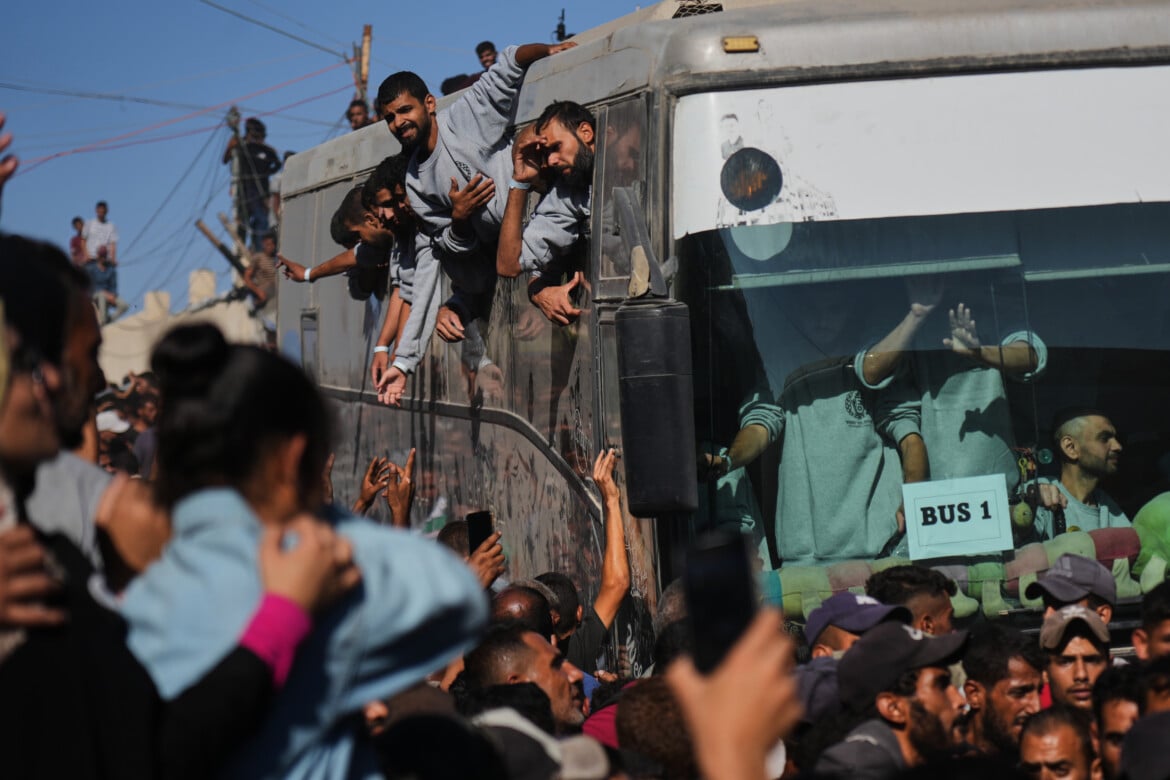Analysis
Prisoners return to a land destroyed, with cries of relief not joy
The elation of the crowds that rushed to welcome the Palestinians at the hospitals seemed more like a collective cry of relief that they had walked out on their own two feet.

The release of nearly 2,000 Palestinian political prisoners is a mosaic of stories that filled Arabic language websites and Telegram channels all day on Monday. Every few minutes, a new notification: a video of an embrace, a photo of a gaunt face, a smile of disbelief, or the tears and cries of those who returned to Gaza to find nothing but ghosts.
The arrival of hundreds of Palestinians in old buses, all dressed in gray prison tracksuits, was no celebration. Every one of them knows the price that was paid for their freedom. The elation of the crowds that rushed to welcome them at the hospitals seemed more like a collective cry of relief that they had walked out on their own two feet.
In Tulkarem, in the West Bank, a wife was dressed in her finest clothes for the return of her husband, Omar Bsais, whom she had not seen in 24 years. In Beit Rima, near Ramallah, a mother collapsed into the arms of her son, Tareq al-Barghouthi; they had not touched in 22 years, not since he was arrested and given a life sentence. In Khan Younis, a man discovers that there’s no one left to welcome him home: his wife and three children have been killed in an Israeli raid.
He trembles in the wheelchair that carries him out, then throws himself to the ground and screams, repeating the same words over and over: “They killed my children.” He holds up a bracelet he made in his cell, a gift for his little girl. “Her birthday is in five days,” he says, still speaking of her in the present tense. “Oh my God, none of them are alive.”
There is Naji al-Jaafrawi, whose first day of freedom turned to excruciating pain: his brother, the journalist and blogger Salah, had been killed just 24 hours earlier by a gang working with the Israeli army. There is a woman who watches the buses but doesn’t see her brother, Mohammed Emran, get off; when she is told he is among the over 150 prisoners exiled outside the West Bank, she faints. She has not seen him in 25 years. There is a young man in Khan Younis, carried on the shoulders of the cheering crowd, who is handed his small son and holds him tight, as if in a dance. There is a boy who clings to a bus window just to get to embrace his brother, who is leaning out, as soon as possible.
And then there are the testimonies. Like that of photojournalist Shadi Abu Sido, who was abducted by the Israeli army on March 18, 2024, at al-Shifa Hospital while documenting the siege: “I was starved for almost two years. They would suspend us naked, beat us and insult us. They told us: ‘We killed your children. Gaza no longer exists.’”
Another former prisoner recounts an escalation of the violence in the final days. Some bear the evidence on their faces, in the bruises around their eyes. Israel’s Channel 13 provides another piece of evidence live on air, broadcasting images of prisoners who are blindfolded, manhandled, forced to walk bent at the waist, and tied to one another as they are led to the buses.
And some are absent, not having gotten off any bus, not in Ramallah, not in Khan Younis, not at the Rafah crossing bound for exile: Marwan Barghouti of Fatah, Ahmad Sa’adat of the Popular Front, Hassan Salameh and Abbas al-Sayyed of Hamas. Dr. Hussam Abu Safiya, the director of Kamal Adwan Hospital who disappeared inside an Israeli tank on December 27, 2024 and has been subjected to abuse ever since, is also not among them.
In total, Israel released 1,968 Palestinian prisoners. The vast majority – 1,718 – were people captured in Gaza during the sieges of cities and refugee camps, rounded up in schools-turned-shelters or in their crumbled homes. Another 250 were prisoners serving life sentences or decades-long terms for armed or political activities during the Second Intifada. Finally, 154 have been exiled to Egypt, Turkey, Algeria or Gaza. “It’s illegal,” Tamer Qarmout, a professor at the Doha Institute for Graduate Studies, explained to Al Jazeera. “They are Palestinian citizens; they have no other citizenship. From a small prison, they are sent to a larger one, far from their society, to different countries where they will face severe restrictions.”
This is a form of forced displacement, experts say, and a double victory for Israel. In the days leading up to the release, as Israeli cities prepared to welcome the 20 hostages who were still alive, the Israeli army banned any form of celebration in the West Bank, dropping leaflets from drones, setting up roadblocks and conducting pre-emptive raids in which the relatives of those about to be freed were themselves arrested. On Monday, it reiterated this ban by firing tear gas and rubber bullets at the waiting families. Meanwhile, 10,000 Palestinian prisoners from East Jerusalem and the West Bank remain in Israeli jails, along with thousands more from Gaza about whom nothing is known.
Originally published at https://ilmanifesto.it/il-ritorno-in-una-terra-distrutta-grida-di-sollievo-non-di-gioia on 2025-10-14
